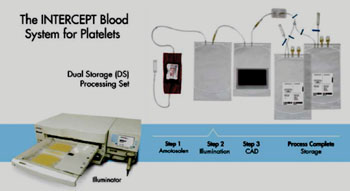Pathogen Reduction System for Treating Platelets Approved
By LabMedica International staff writers
Posted on 15 Jan 2015
Despite 10 years of efforts to improve bacterial culture testing, bacterial contamination of platelet components is the second most common cause of transfusion related death in the USA. Posted on 15 Jan 2015
Platelets are the first line of defense to prevent and treat small blood vessel bleeding, and platelet transfusion is an effective supportive therapy for patients with a low platelet count or non-functioning platelets due to a broad range of conditions.

Image: The INTERCEPT Blood system for platelets (Photo courtesy of Cerus).
While current screening tests for a limited number of pathogens have lowered the risks from transfusion-transmitted infections, these tests are reactive approaches, requiring identification of specific pathogens for which tests can then be developed and implemented. In contrast, pathogen reduction by inactivation is a proactive safety measure, the process can inactivate susceptible viruses, bacteria, and parasites present in platelet components independently of whether they have been identified as specific blood supply risks.
The US Food and Drug Administration (FDA; Silver Springs, MD, USA) has approved The INTERCEPT platelet system (Cerus; Concord, CA, USA) for ex vivo preparation of pathogen-reduced apheresis platelet components in order to reduce the risk of transfusion-transmitted infection (TTI), including sepsis, and to potentially reduce the risk of transfusion-associated graft versus host disease (TA-GVHD). The INTERCEPT systems for both plasma and platelets use the same illumination device, the same active compound (amotosalen) and very similar production steps.
The INTERCEPT Blood System targets this basic biological difference between the therapeutic components of blood, compared to pathogens and donor white blood cells. The system uses a proprietary molecule that when activated by ultraviolet A (UVA) light binds to and blocks the replication of DNA and RNA, preventing nucleic acid replication and rendering the pathogen inactive. The safety and efficacy of INTERCEPT processed platelets has been evaluated in 10 controlled clinical studies, with over 800 study subjects. Routine use of INTERCEPT processed platelets has been monitored in over 4,000 patients in an active hemovigilance studies conducted by Cerus in Europe.
Laurence M. Corash, MD, chief medical officer and scientific officer of Cerus, said, “In Europe, INTERCEPT's capacity to inactivate a broad spectrum of viruses, bacteria, parasites, and leukocytes has allowed blood centers to replace some of the safety methods currently used to prepare platelet components.” The INTERCEPT platelet system was recently made available in the USA under an Investigational Device Exemption (IDE) study to reduce the risk of transfusion-transmitted dengue and chikungunya viruses, both of which are epidemic in the Caribbean region, including Puerto Rico, as well as sporadically in the Southern United States.
Related Links:
US Food and Drug Administration
Cerus














